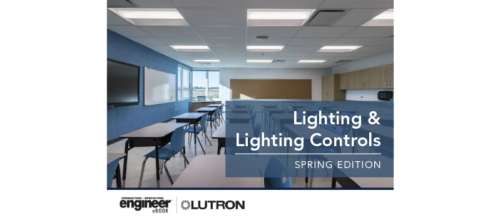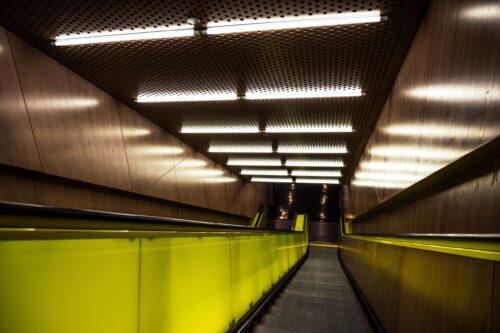Meet the CannonDesign lighting designers
Light has the power to directly and deeply impact experience. Light critically influences atmosphere, enjoyment, health and productivity – not to mention energy consumption. The CannonDesign lighting team includes very passionate designers that are committed to finding the best lighting design solutions for their clients. This is a Q&A to introduce the lighting design team.
CannonDesign’s Lighting Studio currently has five members across three offices: Three of us in Boston (Sara Schonour, Kate St Laurent, and Haley Darst), one in Chicago (Raisa Shigol) and one in Buffalo (Ray Soto). With various backgrounds and many years of combined experience, each member brings our own unique approach to the lighting design profession.
Q: How did you become an architectural lighting designer?
Kate: “I completely fell into lighting design after completing my Masters in Interior Design. I thought it would be a good learning experience, but quickly found that it appealed to my love of puzzles and math problems. It is a perfect mix of creativity and analytics.”
Haley: “I originally thought I wanted to become a civil engineer in high school because I excelled in math and science courses and was interested in designing bridges. After briefly speaking with a professor in college about my love and appreciation for architecture, he suggested I look into the lighting design option within the architectural engineering major. Through coursework and internships in school, I quickly discovered the impact of light on the architectural environment. I realized I wanted to help cultivate these spaces that people play, live, and work in every day.”
Q: What fascinates you about light?
Sara: “What doesn’t? Great lighting is like magic. It brings things…people and spaces…to life. And we’re just beginning to learn how many ways we can create it, how many ways we can use it, how many ways we’re affected by it. Light is more ancient than we are, but the more we understand it, the more we are reinventing and redefining it every day. There will never be a shortage of things to know about light and how we experience it.”
Kate: “I love looking at light in the built environment. Simply put- without light we would not be able to see our designs. When I walk into a new place I look up, under, around and inside any architectural detail that I see lighting coming from. I look with a critical eye and find lessons in the beautiful applications as well as those that fall flat.”
Q: How has lighting design changed since you first started working?
Ray: “It’s now all about energy. When I first started designing in lighting, neither the cost of energy, nor the amount of energy consumed by lighting was a big concern. We used more incandescent lighting then, and luminous ceilings were very popular. And, our light source choices were fewer then. I think the concept of lighting design is still the same, it’s just that we have many more tools at our disposal these days, and our thought process lingers more on the energy side than ever before.”
Raisa: “The lighting industry has changed drastically since I started working, starting with former cutting edge technologies – compact fluorescent, ceramic metal halide, halogen, T5 and T5HO – and now to LED, automatic lighting controls, energy codes, LPD, LEED- you name it. These terms were not even in engineering vocabulary yet. But what has never changed is what role the lighting has played in people and buildings, how powerful lighting is in creating certain moods and atmospheres in a space.”
Q: What is the most misunderstood aspect of lighting design?
Sara: “Lighting doesn’t really do anything by itself. It’s only experienced in context with other surfaces and materials. Great lighting is really just a myth. There’s really only great reflections and interesting interactions of light…with something else. It underscores why lighting isn’t something that can be ‘layered’ into design in the same way engineering or sustainability can’t just be popped in. Great lighting only happens when the effect of light is considered an integral design driver.”
Ray: “I think the most misunderstood aspect of lighting design is the ‘design’ component. Most people think lighting design is ‘fixture picking.’ They forget that there’s both science and art associated with good lighting design. Above and beyond the raw ‘numbers’ (i.e. footcandles, watts per sq. ft., lumens, etc.), there are choices that need to be made with respect to budgets, legislation, and of course appropriateness of providing the right lighting solution for the space. It’s about helping to create an atmosphere in concert with the design team.”
Q: What is your favorite project you worked on and why?
Raisa: “The best projects are those when the client is happy. I have worked on so many different projects (schools, universities, offices, headquarters, hospitals, exterior landscapes, parking, etc), and each one leaves a mark in my memory.”
Haley: “There are many aspects of each project I’ve worked on that are truly unique and special. However, if I had to pick one stand-out project, the UC Riverside Student Recreation Center would be my top pick. This was the first project I ever worked on at CannonDesign from schematic through CA. The lighting design included custom solutions, seamless integration with the architecture, and highly efficient sources and robust lighting controls strategies to aid with aggressive energy targets and requirements in California.”
Do you have experience and expertise with the topics mentioned in this content? You should consider contributing to our CFE Media editorial team and getting the recognition you and your company deserve. Click here to start this process.




